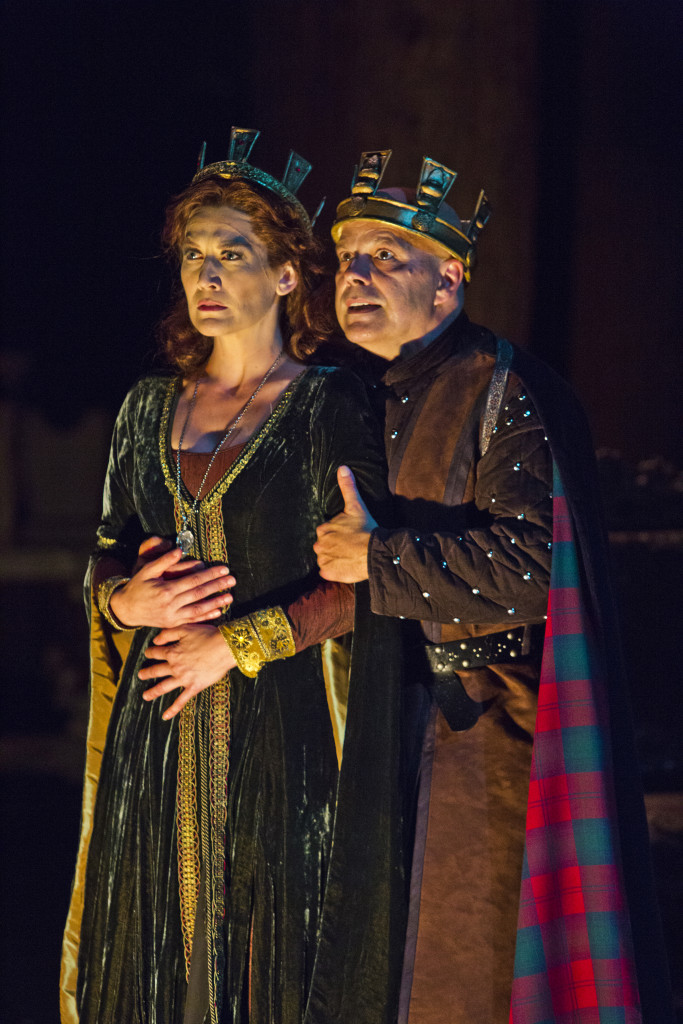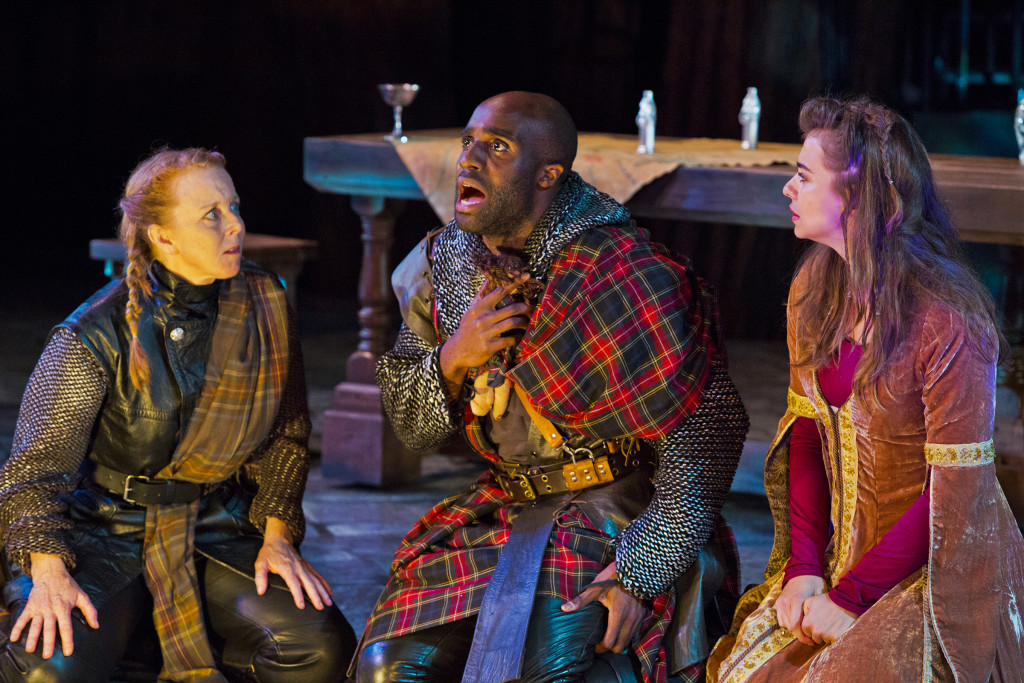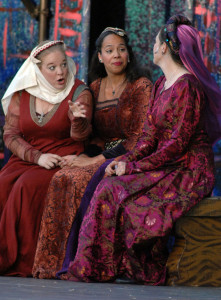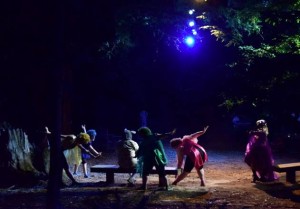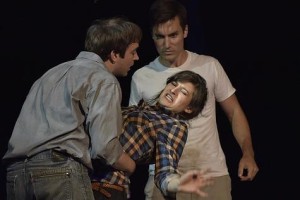Everyone’s a Badass: A review of MACBETH at Santa Cruz Shakespeare
August 12, 2015 § Leave a Comment
In Kristen Brandt’s production of Macbeth, Scotland’s aristocratic class of Thanes is composed equally of hulking men straight out of Braveheart and badass, broadsword-wielding warrior women. This is far from the only way that actresses are especially prominent in Santa Cruz Shakespeare’s current offering, but it is the most viscerally startling. Particularly, the magnificent Greta Wohlrabe’s Banquo (absolutely gendered female without having to become Banqua…) is unforgettable from her first bloody appearance.
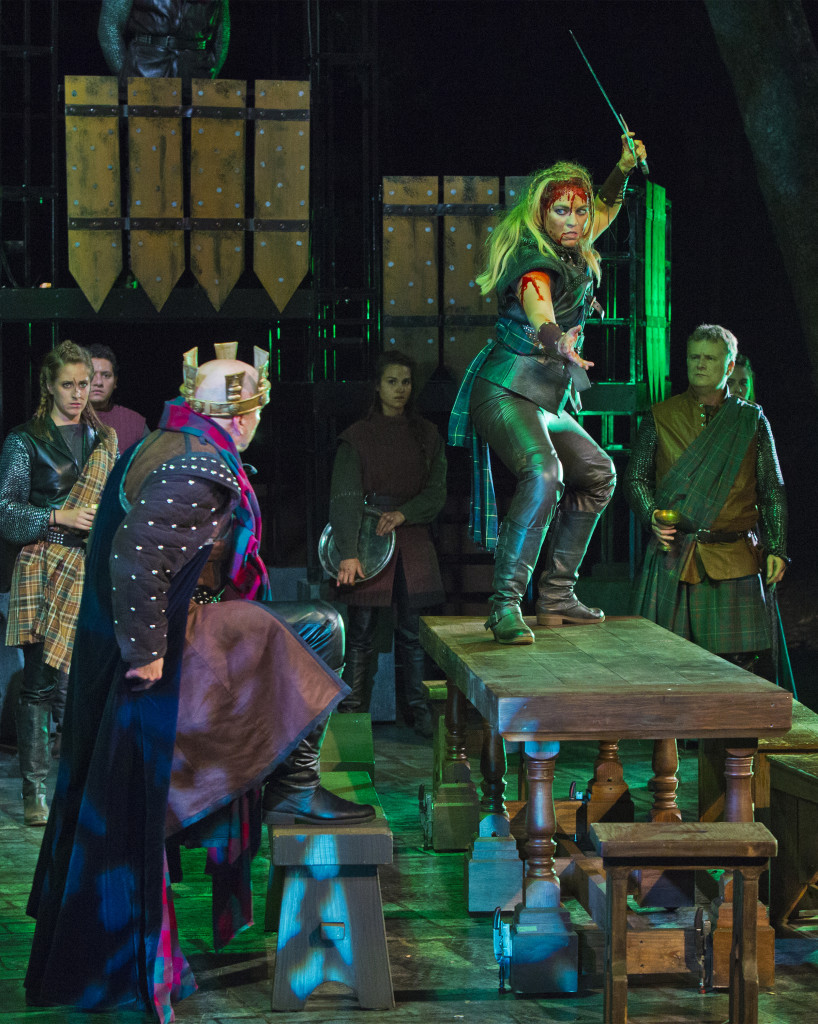
Steve Pickering (Macbeth) and Greta Wohlrabe (Banquo) in Santa Cruz Shakespeare’s Macbeth by William Shakespeare. Also pictured (l. to r.): Madison Kisst, Carlos Angel-Barajas, Kipp Moorman, and Sarah Traisman. Photo by rr jones.
Malcolm, Princess of Cumberland, played by Sierra Jolene; and the Thane of Ross, played by Patty Gallagher, offer more variations on the theme—as do several ensemble players—but even in their less fierce portraits we are closer to Mad Max or an episode of Vikings than the typical Scottish setting.
Sisters and Weird Sisters
Focusing us on women immediately, the play opens with an interpolated scene in which the three “weird sisters” are arrested and accused of collecting body parts from the battlefield for the purposes of witchcraft. This seems to place us in the medieval past, but visually B. Modern’s leather heavy costumes on Nina Ball’s largely metal set combined with the anachronistic female Thanes equally suggested a post-apocalyptic future. Lady Macbeth wears a pre-Raphealite gown that would have made Ellen Terry proud a century ago, but most of the company (women and men) seems perpetually dressed for battle. (I saw an afternoon matinee in the outdoor theatre; Kurt Landisman’s atmospheric lights were effective even though muted.)
The extensive re-gendering of characters (aided by extensive pronoun changes and other textual adjustments) may be more a product of the company’s gender parity policy than the director’s vision, but the immediate effect is a fresh look at the play. Lady Macbeth is tough, but given the world of this production, she does not seem particularly villainous—as an unending stream of misogynistic versions would have her—as much as a product of her times. Her statement that she would kill her own child before backing down on her word (as she accuses Macbeth of considering) seems not monstrous, but simply a matter-of-fact. In director Brandt’s hands, she is also not easily erased. When her death is announced, it is by a character carrying her corpse in a spectacular coup-de-théâtre. The body is immediately handed to Macbeth, and he holds it painfully and awkwardly until he goes forth to fight his final battle.
Oddly, in this world, it is Lady Macduff who seems out of place when she is unwilling or unable to defend herself. Her helplessness does not diminish the tragedy of her murder but it does seem surprising given the number of expert swordswomen we have seen, and have come to accept as unremarkable, throughout the evening.
Feeling as Men
In this particular environment, gender roles are not associated with extremes of masculinity and femininity. Both Steve Pickering as Macbeth, and Toby Onwumere as Macduff, take advantage of this to play more wildly emotional characters than we are used to seeing in these parts. It is a fearless cast, but I would not have predicted that this would manifest in leading men as the ability to play their fears and pain so openly. This was the great revelation of the evening. I did not realize how much, in most Macbeths, the Thane’s masculinity is expressed by emotional detachment and dehumanization until I saw this portrayal which was so vitally alive. Pickering was deeply emotional throughout, especially in soliloquy, and if anything led to his defeat it was that Onwumere (as Macduff) was even more so.
Not everything about the reworking was successful—Malcolm’s equivocating test of Macduff was as interminable as ever, for example—but seeing so much in an altered context kept the production intriguing even when the pace slowed in the second half.
Brandt’s interest was largely in the psychology of character, with the supernatural element substantially less prominent than the Rupert Goold film starring Patrick Stewart or other recent versions. When it came time to kill Banquo, she did select Seyton (Darek Riley) to play the mysterious third murderer, but the insistent pronunciation “SEE-ton,” rather than the punning “Say-tan,” told us that in her vision characters control their own fates rather than being manipulated by evil. In this production, Fleance escaped his assassination because the murderers were inept, not because he was protected.
Brandt is an exciting director. Her production of Merry Wives of Windsor in the same venue a year ago was a revelation because—surprise!—it focused on the wives and not Falstaff. It is not fair to suggest that her production of Macbeth likewise shifts focus to the women. What it does do is re-contextualize both the women and the men so that we can see the story without quite so much sexist baggage. That is a great gift.
Macbeth
August 4–August 30, 2015
Seen August 9
Because It Is the Right Thing To Do: A Review of ROMEO AND JULIET at the San Francisco Shakespeare Festival
August 11, 2015 § 1 Comment
The Artistic Director of the San Francisco Shakespeare Festival, Rebecca J. Ennals, is leading the charge to broaden onstage opportunity in the Bay Area. Her democratizing impulses are prominently on display in her production of Romeo and Juliet, now touring area parks. In addition to featuring actors of color in close to half of the named roles, the production also achieves gender parity by casting actresses in a number of roles that are gendered male. More subtly, the cast also blurs the usually sharp distinction between “character” actors and “leading” actors by utilizing a wide variety of body and voice types in unexpected places.
Improving access onstage is a logical extension of the Festival’s mission of offering free Shakespeare in the park (along the Joe Papp model) to a broad spectrum of community audiences. The performances are enormously popular, playing to large crowds at all four of the Bay Area parks in which performances are held over the course of the summer.
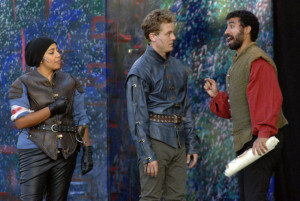
Regina Morones, Carl Holvick and Mohammad Shehata as Benvolio, Romeo and Peter. Photo: Doug Jorgensen
The Concept Is that There Is No Concept
Interestingly, the much-improved diversity is not directly featured as an artistic statement about R&J at all. It is generally treated as invisible in this production. (Or should we say transparent?) That Romeo is a fairly conventionally cast white male who is convincing as a juvenile while Juliet is played by a powerful African-American “leading lady” (rather than an ingénue) is not foregrounded in any way. No West Side Story-style explanations for the feud here.
That Tybalt is played by the obviously female Carla Pantoja, albeit with a false beard to spell out the gender of the character, is just a matter to be taken in stride. She neither makes great effort to hide her underlying gender nor to use it to comment on the mindset of the man she is playing. Regina Morones’ Benvolio is more masculine in execution, but neither her ethnicity nor actual gender is disguised.
If any political point is made by these decisions, it seems to be that in an ideal world they should not matter so very much – and for the most part the production upholds this viewpoint. It is successful as a narrative in which we look through gender, ethnicity, and even the actors’ “types” to see the raw story. Often the surface appearances are contradicting or complicating what we see onstage, but the production offers no consistent viewpoint from that effect. The only convention employed is that we, as audience, are expected to look through the specific representations to a universal theme.
Similar Efforts
It is an interesting and admirable experiment. Similar efforts are going on in many Bay Area Shakespeare festivals this summer. California Shakespeare Festival (known locally as CalShakes) produced an almost all-female Twelfth Night earlier this season in which the actresses quite pointedly (sometimes with hilarious crudity) “commented” on their male personas. The Sacramento Shakespeare Festival produced an original practices (thus all-male) Romeo and Juliet, and then balanced it with an all-female As You Like It. Santa Cruz Shakespeare, meanwhile, is pursuing gender parity in its productions of Much Ado About Nothing and Macbeth, by changing the gender of characters along with all references to their gender in the texts.
In these contrasting examples, the diversity issues are carefully contextualized. Although I prefer this approach, Ennals’ choices are interesting precisely because she offers no internal explanations. The effect is sometimes distracting—I overheard quite a few confused murmurs from nearby audience members—but the crowd eventually accepted that the casting was both color- and gender-blind and stopped trying to read anything more into it.
Uneven Performances
The quality of the performance is uneven, but not because of anything having to do with the diversity choices. The scene painting is amateurish and Ashley Holvick’s costumes, although much better executed, are conventional. Ennals’ staging is frequently messy, and occasionally just odd. (The “morning after” scene, for example, is played on stage level, so the balcony-less Romeo is forced to jump down into the crowd in order to have any sort of descent.) The extensive doubling is successful, although at one point it becomes logistically complicated: Phil Lowery’s Friar Laurence having to be onstage in the final scene means that his Lord Montague cannot be. In the only significant rewriting, therefore, Lady Montague appears onstage in the final scene as peacemaker after the surprising news (to those that know the show well) that her husband has just died.
Romeo and Juliet are compellingly portrayed by Carl Holvick and Lauren Spencer, respectively. Their chemistry and energy are engaging. Spencer’s Juliet is more mature from the outset than any I have seen in years, but she is more effective in the last half of the show than most because she is not childish and she clearly understands the choices she is making. (It is actually kind of refreshing, for once, not to have to focus so hard on overcoming the inherent creepiness of men drooling over a thirteen-year-old.)
Gwen Loeb is wonderfully loud and bawdy as Juliet’s nurse, and in a doubling returns as the usually absent Lady Montague for the final scene, taking over all of her husband’s traditional lines. Phil Lowery’s Friar Laurence is earnest at every turn, and more sympathetic than usual. Mohammed Shehata is a powerful Prince Escalus, and is unrecognizable in his doubling as Peter, which speaks to his versatility. The rest of the cast is serviceable, without anyone standing out in either good or bad ways.
The show features two very surprising—and I think less than successful—choices of convention: in the first, whenever the play features a rhyming couplet with an historic rhyme (that is, one where the words once rhymed but because of pronunciation changes no longer do, such as love/prove or die/remedy) the original pronunciation of one or both is restored to regain the rhyme. That is actually fascinating, but certainly seems odd when numerous other original pronunciation issues—such as preservation of puns or scansion—are ignored.
The second is that after the epilogue, a traditional jig is performed by the full cast as the curtain call. It is not quite historically correct as original practice, as such jigs were separate entertainments (usually with risqué lyrics to songs in addition to the dancing) in Shakespeare’s time and not curtain calls. It was also not quite effective on its own terms since it broke the somber mode without transition or explanation. In these cases, the lack of contextualization (which worked for the casting) was problematic.
As of this writing, the show has finished its run in Pleasanton and Cupertino. It plays Saturdays and Sundays in Redwood City through August 23rd, moves to the Presidio in San Francisco through September 13th, and finishes its run at McLaren Park in SF, on September 27th.
Romeo and Juliet
San Francisco Shakespeare Festival
June 27 – Sept. 27, 2015
Various Locations throughout the Bay Area
Seen August 2, 2015
Never Anything Can Be Amiss: A Review of A MIDSUMMER NIGHT’S DREAM at Portola Valley Theatre Conservatory
August 2, 2015 § Leave a Comment
In their current offering, The Portola Valley Theatre Conservatory creates a conceptually-exciting, immersive staging that engaging explores the contrast between the soul-crushing city and the wild forest at the thematic heart of A Midsummer Night’s Dream.
Portola Valley is a rustic coastal California town, so bucolic that it is hard to believe it is only a half-hour south of bustling San Francisco, and within easy hiking distance of Stanford University. Tucked in between two large land preserves, it is a small dot of civilization placed amidst the giant redwoods. PVTC utilizes this arrangement in its site-specific setting to the fullest.
Site-specific and Immersive
The concept is initiated when one’s reservation is confirmed with a charming (and very contemporary) e-mail in the form of an invitation to Duke Theseus’ upcoming wedding. Along with the ubiquitous engagement photo, it gives the time and place, with a suggestion that the dress code is “layers” and guests might want to bring insect repellent.
Arriving at the site, which turns out to be a local protestant church, one is greeted at the edge of the parking lot by wedding ushers who – completely in character – apologize profusely that things are not quite ready for the ceremony, and in a disturbingly realistic scenario, ask the small audience to cool its heels outside while last-minute arrangements are completed.
When we are finally herded inside, we are led first to a small set representing the office of a wedding planner complete with piles of bridal magazines, catering menus and other commercial paraphernalia that overburdens modern weddings. The contemporary tone is reinforced by Hippolyta (Sarah Benjamin), who wears a t-shirt with a variation on a familiar meme that says, “I can’t keep calm and carry on, I am the bride.” The audience shares the space with the actors, standing around the edges or just sitting down on the floor to watch Egeus intrusively demand that the distracted Duke (Bryce Chaddick) force his daughter, Hermia, (Lydia Cuffman) – against her will – to marry Demetrius (William J. Brown III), instantly identifiable as a hipster because he is wearing his fashionable sunglasses inside.
Take a Hike
After the first scene plays out, we are urged to follow Hermia and her beloved, Lysander (Matt Waters), into the woods where they are fleeing in hiking gear – complete with backpacks and sleeping bags. They are tailed by Demetrius’ ex, Helena (Alanna McNaughton) and by Demetrius, himself. While heading out toward a redwood grove, we encounter the rude mechanicals preparing their play in a courtyard, and pass a strategically placed fairy queen (Cheryl Goodman-Morris) preening over a changeling boy (John Max Byrne).
The second and third acts of the play are staged in the midst of a towering redwood grove, which is directly referenced in the performance in a clever substitution for Shakespeare’s hawthorn brake. (In a similar textual alternation, they will discover in the almanac that not only does the moon shine when they need it, but that it will be the Blue Moon that actually graced the performance.) Although conveniently lit with theatrical instruments and accompanied by Shane Turner’s live score, it is still the dust, stones, sticks and pine scent in the clearing where we gather that make the long night in the woods tactile and immediate. Kevin Gibbs is credited with the “Aesthetic Design.” Even when “off-stage,” fairies hover in the shadows and the sound of the living forest is always present. The scene seems literally enchanting.
My favorite piece of staging happenes on the trip back from the woods, when we observe Bottom’s friends anxiously scouting the horizon for any sign of him – all sitting on the parish hall rooftop. Talk about site-specific! Later we are led back inside to an interpolated, but nicely moving, triple wedding in the chapel, featuring a beautiful tenor solo by Don Gustafson (who also plays Egeus.)
From there we finish our evening on a candlelit patio, drinking champagne and munching petit-fours while (along with the Duke and his party) we enjoy the heartfelt entertainment presented by the rustics. (Ashley Pogue, Andrew Saier, Mark Goodman-Morris, Angela Khalipa, and John Kissel make up this motley crew, along with Andrew P. Quick in the always scene-stealing role of Flute/Thisbe.)
I’m Feeling It
By far the most interesting part of the evening was director Noëlle GM Gibbs’ immersive staging, perfectly fitted to the play. Her conceptual aim sometimes exceeded the grasp of her largely amateur cast, but the aim was, nonetheless, always true. Is there any place that better represents the unromantic excesses of social conformity than a wedding planner’s salon? Conversely, can there be any better way to realize the mystic power of nature than to take us – even a little way – out into the forest? (What was that sound, anyway, and what did I just step on?)
Having seen Midsummer dozens of times, I cannot recall having ever experienced the woods so powerfully. The visceral power of immersive staging, however forced it may initially seem, can transform an ordinary performance into a fully absorbing aesthetic experience as you begin to feel yourself part of the action and the environment becomes a character in the drama.
Unsurprisingly, the Equity guest artist William J. Brown III, as Demetrius, gives the best performance of the evening. (Brown is the Artistic Director of the Arabian Shakespeare Festival, and an actor whose work I have previously admired.) Matt Waters as Lysander and Bryce Chadwick as Theseus also give especially compelling performances.
This production gives unusual prominence to the lovers, and their journey of self-discovery over the course of the night is treated without condescension. They are funny, but more than farcical. The inability to know who we are when overburdened by the demands of civilization, and the liberation of finding our natural selves, emerge as serious themes for once. (Brown’s terrific moment of conversion upon waking from his night in the woods and realizing that he really does love Helena is about as good as acting gets.)
The evening was certainly not without its deficits. The scansion was something of a disaster throughout, and the fairies were garishly costumed Victorian conceptions surprisingly out-of-keeping with natural woods in which they were located. If ever wildly folkloric, instead of tame balletic, fairies were called for, this was the time!
Still, given a play that so thoroughly praises and celebrates the effective sincerity of amateur actors who are giving it their best shot, it would be churlish to deny their winning charm in this case. (I’ve certainly witnessed many fully professional productions that were both less interesting in their ideas and less engaging in their presentation.) Life and art converge in the final scene, where both the characters and their real-life interpreters rise to the occasion when the moment calls for it, and the effect is deeply moving. This is Shakespeare’s love-letter to the theatre, and PVTC’s innovative production makes us see it – no, experience it – freshly and intensively.
A Midsummer Night’s Dream
Portola Valley Theatre Conservatory
July 30 – August 2, 2015
Seen (under the Blue Moon) on July 31
